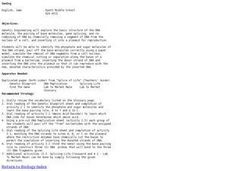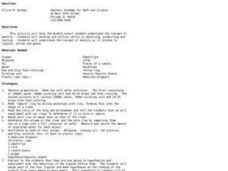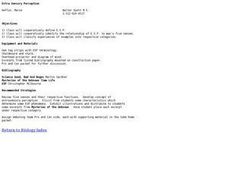Curated OER
Biology Trivia Questions
Students answer 71 questions about a variety of topics in biology. In this biology trivia lesson plan, students use the internet to find the answer to questions about the systems of the body, their structures and functions, the different...
Curated OER
Observations (collecting data)
Students observe and collect data about the earthworm. In this observation of an earthworm lesson plan, students use an earthworm to determine the effects of light and incline on the earthworm's behavior. They practice making...
Curated OER
Problem Solving: Dots, Symbols, Words and Proteins
Students use symbols and dots to investigate the amino acids in a protein. In this problem solving lesson plan, students use dots and symbolic analogies to solve problems using the IDEAL problem solving method which includes identifying...
Curated OER
Water Conditions
Young scholars investigate the importance of water in an environment with living things. in this water conditions lesson plan, students soak radish sees in water, vinegar, soap and alcohol. Young scholars remove the seeds, store them for...
Curated OER
Physical and Chemical Change of Six White Substances
Students investigate chemical and physical changes in reactions. In this chemical and physical change lesson plan, students mix 6 different white substances with water, vinegar and iodine. They make hypotheses about each substance and...
Curated OER
The Frigid Gourmet
Students make a " science surprise" or ice cream in the lab. In this melting point depression lesson plan, students use various substances with ice to determine the effects on the melting point of ice and the ability to make ice cream....
Curated OER
GenEng
Students investigate the process of genetic engineering. In this genetic engineering lesson plan, students use paper models of DNA and plasmid bacterium to investigate the process of replicating DNA, splicing genes from DNA, and...
Curated OER
Paper Chromatography-Chemical and Mechanical
Students perform paper chromatography to determine pigments in plants. In this paper chromatography lesson plan, students isolate leaf pigments, prepare a chromatogram and place their chromatogram in a solvent to separate the pigments....
Curated OER
Densities
Students explore the concept of density. In this density lesson plan, students determine the density of a crown and a sample of clay. They hypothesize about the densities of 4 liquids they are given including molasses, cooking oil, a red...
Curated OER
The Sense Of Touch
Students explore the sense of touch. For this science lesson plan, students participate in hands-on activities that broaden their perspectives pertaining the sense of touch.
Curated OER
How Do Toxins Affect the Human Body?
Young scholars study toxins. In this biology lesson plan, students identify toxins contained within household products and determine specific affects that toxins may have on the human body.
Curated OER
Cardiorespiratory Fitness
Students explore cardiorespiratory fitness. In this biology lesson plan, students gain an understanding of pulse rates in order to compare lung capacities of active and inactive males and females. They also learn how to take and compare...
Curated OER
Dinosaurs---Read All About Them!
Students read all about dinosaurs. In this biology lesson plan, students examine how to use library research as integral part of scientific research.
Curated OER
Testing Fats in Food
Students consider the fats found in foods. In this science lesson plan, students test the presence of fat in foods and become more aware of their daily diets.
Curated OER
A Guinea Pig Makes An Excellent Classroom Pet
Third graders live alongside guinea pigs. In this biology lesson plan, 3rd graders gain direct knowledge of the guinea pig's behavior and determine if it will make a good classroom pet.
Curated OER
The Effects of Trash and Garbage On the Environment
Students recognize the importance of solid waste management. In this science lesson plan, students analyze individual solid waste management habits as they enhance their knowledge of solid waste disposal and the recycling process.
Curated OER
The Effects of Pesticides on the Food Chain
Fourth graders generalize that all animals, including people, depend on plants as a food source. In this science lesson plan, 4th graders describe and construct a food chain, tell how pesticides enter the food chain, and discuss possible...
Curated OER
Usefulness of Irrigation
Students explore irrigation. In this science lesson plan, students show that water is necessary for plant growth and show how a dam can turn a nearly useless water way into a valuable form of irrigation.
Curated OER
Extra Sensory Perception
Students define extra sensory perception. In this science lesson plan, students identify the relationship of E.S.P. to man's five senses and classify experiences of examples into respective categories.
Curated OER
For Safety's Sake: Introduction to Laboratory Safety in Science
Students practice safety in and out of the science laboratory. In this science lesson plan, students consider a list of safety precautions and guidelines as they apply to the science laboratory and associate the correct laboratory safety...
Curated OER
Passing The Heat Along
Fifth graders consider conduction. For this science lesson plan, 5th graders explore how heat passes through conductors and examine materials that contain heat.
Curated OER
Dispersement of Particles: Diffusion and Osmosis
Students explore the dispersement of particles. In this science lesson plan, students describe the many ways in which particles move and transfer from one source to other areas.
Curated OER
The Conservation Of Mass (The Mass Of Gas)
Students gain an understanding of matter in all of its phases. In this science lesson plan, students further their knowledge of the laws of conservation of mass, the loss in mass can be accounted for, when the gas is allowed to escape...
Curated OER
Acid Rain Environment Pollution
Students combine different materials to create chemical reactions. In this chemical reaction lesson plan, students will combine different materials to create chemical reactions and define these results as acids or bases. They will also...























